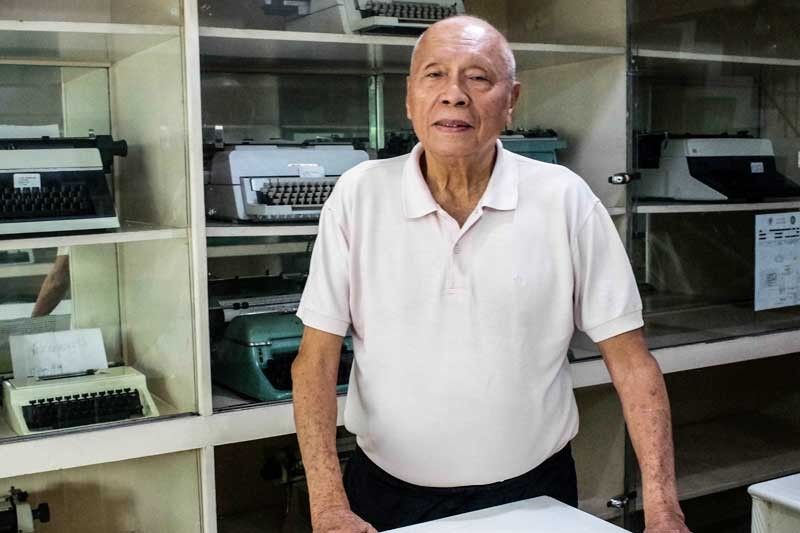By The Keystroke

‘This is where I started. But I know all of this will end with me. The typewriter is my life. What would I do all day if I stopped?‘ Ramon Avena wonders.
MANILA, Philippines — Across the roundabout of España in Old Manila is Avena and Sons. The quaint establishment with large Dutch windows is one of the last typewriter stores in Manila. ?The room is filled with typewriters of all shapes and sizes. Ramon Avena, the owner who still runs the place, is a tall and sturdy gentleman in his mid-80s. A couple of years ago I bought a fully refurbished Remington Monarch, which to this day still works like a charm. ?Avena’s family owns the low-rise building and lets out the remaining rooms to tenants. His parents established a sporting goods store on the side of town now known as Recto, before shifting to typewriters in 1939. They moved to its current and final location in the 1960s. Ramon learned the trade as a child. His father, Vicente Avena, was an accomplished sportsman and represented the Philippine basketball team in the 1920s Far Eastern Olympics.
For close to 80 years, the family shop has been refurbishing and repairing old typewriters.
Avena is one of the last remaining typewriter repairmen left in a city that was once overflowing with the clicking and clacking of mechanical keys on paper. ?The typewriter was first sold commercially in 1874. It did not become common in workplaces until the mid-1880s. Long before we had email inboxes, there were high piles of paper stacked with impulsively written letters made on heavy metal contraptions. It was an essential tool for professionals in offices, writers, businesses, and even for personal correspondence in private homes. ?The typewriter has a cluster of keys allowing a single character to be printed on paper with each keystroke using an inked ribbon. The QWERTY keyboard layout was developed to help keep keys from jamming. It became so successful with the 1878 Remington that it has remained in use with standard electronic keyboards to this day. ?“The quick brown fox jumps over the lazy dog” is an English phrase that contains all 26 letters of the English alphabet. Generations born before the personal computer and the internet all had to learn to type the phrase in school — repeatedly, and at high speeds.
The heavy mechanical machine with all its nuts and bolts can outlast any computer keyboard. The current millennial obsession with artistry and nostalgia has brought about a typewriter revival. There is something romantic about sitting before a blank page and a typewriter with no other distractions. You see each word hit the paper. The sounds are mesmerizing, just as we are entranced in listening to the sound of a needle on an old record. Ideas are printed out before us, translated into ink. Writers such as Ernest Hemingway, Mark Twain and Orson Welles became associated with the brand of typewriters they used.?As we walk towards Avena’s desk, a man works patiently on a deco period Underwood along a well-ventilated terrace. On the floor leading to the terrace there’s a graveyard of old typewriters — each with a paper note of the date and owner neatly placed on the top carriage. There is a long line of repairs and restorations for people willing to wait. A medium-sized notebook holds Avena’s handwritten list of clients, including a few famous personalities. The business has survived the Japanese occupation and a World War. ?Every typewriter brought to the store for repair has a personal history, a story some hold onto as a memento of a loved one who has passed.?Times have changed since the days when government offices, universities and companies would regularly call upon his services. At present, two typewriters are repaired a day and if he’s lucky, he sells one a week. Surprisingly there are still select offices that choose to keep a mechanical typewriter on hand to fill in bulky forms that need a hard carbon copy. Under a tree near a town hall, you may still hear the sound of clerks typing.
The recycled parts of cannibalized typewriters from every brand imaginable are placed in well-organized glass bottles. The smell of paint thinner and oil fills the air. A wide metal filing cabinet carries an abundance of steel, rollers, spools and keys.
“I have kept everything,” Avena exclaims as he pulls out a drawer with small wooden compartments, each holding a separate letter of the alphabet. His faithful assistant Nemecio Matalang has been with him since 1972. Daily, from 7 a.m. to 6 p.m. except for Sundays, Avena & Sons has remained open for the past 70 years. Sadly, no member of his family has shown any interest to continue the trade. ?Avena recently turned 85. He rides the jeepney to work every day and has no plans of retiring.
“I enjoy coming in,” he says. “This is where I started. But I know all of this will end with me. The typewriter is my life. What would I do all day if I stopped?”














